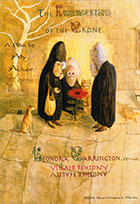
The Flowering of the Crone: Leonora Carrington, Another Reality 2014
Distributed by Reel Women Media, 8 Hayloft Lane, Roslyn Hts, NY 11577; 516-621-2525
Producer n/a
Directed by Ally Acker
DVD , color and b&w, 58 min.
Sr. High - General Adult
Films, Art History, Feminism
Date Entered: 03/16/2015
Reviewed by Oksana Dykyj, Head, Visual Media Resources, Concordia University, MontrealThe Flowering of the Crone: Leonora Carrington, Another Reality is a very personal ode to the artist (1917-2011) who is often associated with the surrealist movement. She was thought not to be a surrealist in the very strictest sense of the word, but she was influenced by that closely interconnected group of artists in France in the 1920s and 1930s. Numerous interviews with this formidable woman exist, particularly from her later years, and filmmaker Ally Acker has been able to supplement her own work with footage from the BBC, the CBC and Mexican documentaries. Acker’s is the American documentary on the artist while there are also concurrent French and Spanish ones that were produced at about the same time. How interesting that this woman, who has been very famous in Mexico where she lived since the 1940s, is now resurfacing posthumously in 3 feature-length documentaries.
What makes Carrington such an interesting subject? She was an artistically-inclined rebel debutante from a rich British textile-manufacturing family, who, at 19, ran off with Max Ernst, a then, twice married, and much older famous surrealist. Shortly thereafter, World War II entered the picture and Ernst was arrested first by the French government as an enemy alien and then by the Gestapo for “degenerate art”. He was aided to freedom in the United States by Peggy Guggenheim who became his third wife. Meanwhile, Leonora Carrington suffered a horrible mental breakdown, or “breakthrough” as some art historians like to postulate, married a Mexican diplomat in order to emigrate, and settled in Mexico. She divorced the diplomat and married the Hungarian photographer Imre Weisz (1911–2007) with whom she had two sons. In Mexico she nurtured friendships with many writers and artists, which Acker particularly emphasizes. Carrington’s friendship with Remedios Varo is highlighted, pinpointing the similarities in their painting styles and subject matter. The section on their friendship and their art is important and also draws attention to Varo, whose work is increasingly more recognized. Carrington became part of a group of predominantly Mexican artists commissioned to produce works to reflect Mexico’s culture. For example, she created a mural for Mexico's National Museum of Anthropology, and, as is often the case, despite not being that well regarded in Britain, she became a national treasure in her adopted country.
Art historians Whitney Chadwick and Gloria Orenstein discuss her interest in alchemical imagery and her concern with animal/human interactions in her paintings. Although no dates are provided, the footage of these discussions appears to be at least fifteen years old. It would have been interesting to have them update their thinking in more recent interviews, particularly since there appears to be so much more focus placed on Carrington after her death with large scale museum exhibitions. The chapter divisions on the DVD are very well organized to access various topics under discussion with sections on Carrigton’s writings and sculpture as well.
The greatest challenge for this documentary is the age of much of the video footage. A great deal of the source material for this film was either in VHS format or copies degraded to even lower resolution. Viewers’ eyes are now becoming accustomed to Ultra High Definition and 4K, just as their smart phones shoot videos at 1080p or better resolution. Thus, watching so much low resolution video with its inherent problems is somewhat jarring, especially when examining the art works themselves. There are also some minor problems with the sound, and end credits indicate that an audio restoration was performed in order to marry and clean up the various audio sources for the documentary. Assembling a film from old, sometimes unstable video footage is a very difficult task but Acker manages to skillfully complete the documentary she has been making for a very long time. Recommended for the academic areas of feminist art history and art history of the 20th Century.